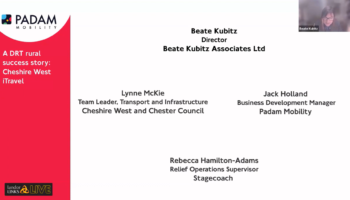The efficiency and success of a demand responsive transport (DRT) service is based on several steps. In this article, we will discuss the two other essential steps to the implementation of an efficient dynamic demand responsive transport service: the extension of the service and the technical and new use case integrations. essential steps for a demand responsive transport
What is a dynamic DRT?
The aim of a dynamic DRT is to rationalise public transport by adapting supply more closely to demand with more interesting economic and ecological benefits. Vehicles, reserved via a mobile application, a website or a call centre, replace underused or non-existent fixed lines. Their route is optimised thanks to algorithms.
Step 3: Service extension
The service extension stage is a move to scale aimed at perpetuating DRT to make it a structuring element of the mobility offer in the area in which it operates, to overcome the weaknesses of the existing transport network or to rethink the area’s public transport service plan by opening up poorly connected areas.
This step is used to identify the areas and use cases that best lend themselves to DRT in order to replicate the DRT model. It enables a “tools” strategy to be defined and implemented, following integration logics aimed mainly at replacing deficient fixed lines and/or converting under-utilised services.
The main challenges in extending the service are based on the method of acquiring the DRT software (calls for tender, over-the-counter, etc.), the balance with the rest of the network, integration with the existing network and its tools, performance monitoring and consolidation of service quality criteria.
What indicators should be taken into account at this stage?
- The same as those of the pilot (step 2)
- Acquisition, retention, use, mileage and knowledge of users.
What questions should be asked before moving on to the next step?
- Are there other needs or cases of unaddressed uses?
- What is the capacity to replicate the service operationally in other areas, possibly with different operations or use cases?
Step 4: technical integrations and new use cases
The principle of technical integrations:
- Adding new use cases to the existing DRT platform at marginal cost and benefiting from their advantages. In particular, this makes it possible to pool operating and management costs (vehicles, drivers, etc.).
- To meet specific needs (e.g. transport of healthcare personnel in the event of a health crisis, substitution services in the event of works, occasional / event transport).
Cases of use that can be integrated:
- Other shared public transport: Paratransit, school transport, evening service in stations without reservation, airport shuttles, etc.
- Occasional transport: transport of healthcare staff in the event of a health crisis, substitute services in the event of works, occasional / event transport (e.g. a concert or football match).
Technical integrations are used to make DRT a brick perfectly integrated in your MaaS (Mobility as a Service) vision. As an aggregator of mobility solutions, it aims to offer individuals the opportunity to visualize their journeys from end to end regardless of the type of transport used (public/private, shared, soft, mass, etc.).
In practice:
- DRT platform integrates with the local MaaS and allows users to complete their public transit trips with DRT.
- The DRT itself integrates with the network, synchronizing with train schedules for example.
- Finally, other transport solutions exist, such as carpooling, bike sharing, car sharing, taxis/VTC etc. The DRT can be combined with these other forms of transport to complete its offer when it becomes saturated. For example, the DRT platform can offer carpooling or taxi/VTC alternatives when no DRT is available in the next half hour, and vice versa.
Learn more about the integration of MaaS in Padam Mobility solutions
Our experience in DRT design, configuration and optimisation leads us to the observation of these 4 steps that we consider to be a good factor of success and efficiency of an DRT service. The success of an DRT service mainly includes user satisfaction with the service. In all cases, the best approach to adopt always consists in getting in touch with a dynamic DRT professional who will be best able to advise you in the implementation of your service.
Learn more about the two other essential step 1/2





